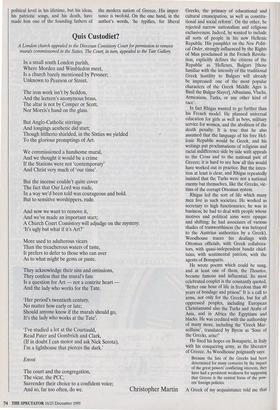Quis Custodiet?
A London church appealed to the Diocesan Consistory Court for permission to remove murals commissioned in the Sixties. The Court, in turn, appealed to the Tate Gallery.
In a small south London parish, Where Morden and Wimbledon meet, Is a church barely mentioned by Pevsner; Unknown to Pearson or Street.
The iron work isn't by Seddon, And the lectern's anonymous brass, The altar is not by Comper or Scott, Nor Morris's hand on the glass.
But Anglo-Catholic stirrings And longings aesthetic did start; Though hitherto shielded, in the Sixties we yielded To the glorious promptings of Art.
We commissioned a handsome mural, And we thought it would be a crime If the Stations were not 'contemporary' And Christ very much of 'our time'.
But the incense couldn't quite cover The fact that Our Lord was nude, In a way we'd been told was courageous and bold, But to sensitive worshippers, rude.
And now we want to remove it, And we've made an important start; A Church Court Consistory will adjudge on the mystery: `It's ugly but what if it's Art?'
More used to adulterous vicars Than the treacherous waters of taste, It prefers to defer to those who can aver As to what might be gems or paste.
They acknowledge their sins and omissions, They confess that the mural's fate Is a question for Art — not a contrite heart And the lady who works for the Tate.
`Her period's twentieth century, No matter how early or late; Should anyone know if the murals should go, It's the lady who works at the Tate'.
`I've studied a lot at the Courtauld, Read Pater and Gombrich and Clark, (If in doubt I can motor and ask Nick Serota), I'm a lighthouse that pierces the dark.'
The court and the congregation, The vicar, the PCC, Surrender their choice to a confident voice; And so, far too often, do we. Christopher Martin










































































































 Previous page
Previous page